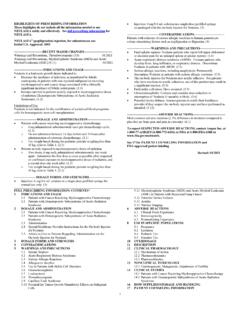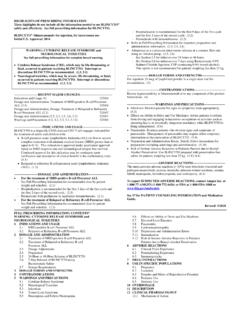Transcription of HIGHLIGHTS OF PRESCRIBING INFORMATION …
1 HIGHLIGHTS OF PRESCRIBING INFORMATION Hypocalcemia: Xgeva can cause severe symptomatic hypocalcemia, and These HIGHLIGHTS do not include all the INFORMATION needed to use fatal cases have been reported. Correct hypocalcemia prior to initiating XGEVA safely and effectively. See full PRESCRIBING INFORMATION for Xgeva. Monitor calcium levels during therapy, especially in the first XGEVA. weeks of initiating therapy, and adequately supplement all patients with Xgeva (denosumab) injection, for subcutaneous use calcium and vitamin D.
2 ( ). Initial Approval: 2010 Osteonecrosis of the jaw (ONJ) has been reported in patients receiving Xgeva. Perform an oral examination prior to starting Xgeva. Monitor for symptoms. Avoid invasive dental procedures during treatment with ------------------------------RECENT MAJOR CHANGES------------------------ Xgeva. ( ). Indications and Usage, Multiple Myeloma and Bone Metastasis from Solid Atypical femoral fracture: Evaluate patients with thigh or groin pain to Tumors ( ) 01/2018 rule out a femoral fracture. ( ). Warnings and Precautions, Hypercalcemia Following Treatment Hypercalcemia Following Treatment Discontinuation in Patients with Discontinuation ( ) 06/2018.
3 Giant Cell Tumor of Bone and in Patients with Growing Skeletons: Warnings and Precautions, Multiple Vertebral Fractures (MVF) Following Monitor patients for signs and symptoms of hypercalcemia, and manage Treatment Discontinuation ( ) 01/2018. as clinically appropriate. ( , ). Warnings and Precautions, Embryo-Fetal Toxicity ( ) 01/2018. Multiple Vertebral Fractures (MVF) Following Treatment Discontinuation: When Xgeva treatment is discontinued, evaluate the ---------------------------INDICATIONS AND USAGE---------------------------- individual patient's risk for vertebral fractures.
4 ( ). Xgeva is a RANK ligand (RANKL) inhibitor indicated for: Embryo-Fetal Toxicity: Can cause fetal harm. Advise females of Prevention of skeletal-related events in patients with multiple myeloma reproductive potential of potential risk to the fetus and to use effective and in patients with bone metastases from solid tumors. ( ). contraception. ( , , ). Treatment of adults and skeletally mature adolescents with giant cell tumor of bone that is unresectable or where surgical resection is likely to result in severe morbidity.
5 ( , ) --------------------------------ADVERSE REACTIONS----------------------------- Treatment of hypercalcemia of malignancy refractory to bisphosphonate Bone Metastasis from Solid Tumors: Most common adverse reactions therapy. ( ) ( 25%) were fatigue/asthenia, hypophosphatemia, and nausea. ( ). Multiple Myeloma: Most common adverse reactions ( 10%) were -----------------------DOSAGE AND ADMINISTRATION----------------------- diarrhea, nausea, anemia, back pain, thrombocytopenia, peripheral Xgeva is intended for subcutaneous route only and should not be edema, hypocalcemia, upper respiratory tract infection, rash, and administered intravenously, intramuscularly, or intradermally.
6 ( ) headache. ( ). Multiple Myeloma and Bone Metastasis from Solid Tumors: Administer Giant Cell Tumor of Bone: Most common adverse reactions ( 10%). 120 mg every 4 weeks as a subcutaneous injection in the upper arm, were arthralgia, headache, nausea, back pain, fatigue, and pain in upper thigh, or abdomen. ( ) extremity. ( ). Giant Cell Tumor of Bone: Administer 120 mg every 4 weeks with Hypercalcemia of Malignancy: Most common adverse reactions additional 120 mg doses on Days 8 and 15 of the first month of therapy. (> 20%) were nausea, dyspnea, decreased appetite, headache, peripheral Administer subcutaneously in the upper arm, upper thigh, or abdomen.
7 Edema, vomiting, anemia, constipation, and diarrhea. ( ). ( ). Administer calcium and vitamin D as necessary to treat or prevent To report SUSPECTED ADVERSE REACTIONS, contact Amgen Inc. at hypocalcemia. ( , ) 1-800-77-AMGEN (1-800-772-6436) or FDA at 1-800-FDA-1088 or Hypercalcemia of Malignancy: Administer 120 mg every 4 weeks with additional 120 mg doses on Days 8 and 15 of the first month of therapy. Administer subcutaneously in the upper arm, upper thigh, or abdomen. -------------------------USE IN SPECIFIC POPULATIONS---------------------- ( ) Pediatric patients: Recommended only for treatment of skeletally mature adolescents with giant cell tumor of bone.
8 ( ). ----------------------DOSAGE FORMS AND STRENGTHS--------------------- Renal impairment: Patients with creatinine clearance less than Injection: 120 mL (70 mg/mL) solution in a single-dose vial (3) 30 mL/min or receiving dialysis are at risk for hypocalcemia. Adequately supplement with calcium and vitamin D. ( ). --------------------------CONTRAINDICATI ONS---------------------------------- Hypocalcemia ( ) See 17 for PATIENT COUNSELING INFORMATION . Known clinically significant hypersensitivity to Xgeva ( ). -------------------------WARNINGS AND PRECAUTIONS---------------------- Same Active Ingredient: Patients receiving Xgeva should not take Revised: 06/2018.
9 Prolia . ( ). Hypersensitivity reactions including anaphylaxis may occur. Discontinue permanently if a clinically significant reaction occurs ( ). Page 1. FULL PRESCRIBING INFORMATION : CONTENTS*. 1 INDICATIONS AND USAGE 8 USE IN SPECIFIC POPULATIONS. Multiple Myeloma and Bone Metastasis from Solid Tumors Pregnancy Giant Cell Tumor of Bone Lactation Hypercalcemia of Malignancy Females and Males of Reproductive Potential 2 DOSAGE AND ADMINISTRATION Pediatric Use Important Administration Instructions Geriatric Use Multiple Myeloma and Bone Metastasis from Solid Tumors Renal Impairment Giant Cell Tumor of Bone 10 OVERDOSAGE.
10 Hypercalcemia of Malignancy 11 DESCRIPTION. Preparation and Administration 12 CLINICAL PHARMACOLOGY. 3 DOSAGE FORMS AND STRENGTHS Mechanism of Action 4 CONTRAINDICATIONS Pharmacodynamics Hypocalcemia Pharmacokinetics Hypersensitivity 13 NONCLINICAL TOXICOLOGY. 5 WARNINGS AND PRECAUTIONS Carcinogenesis, Mutagenesis, Impairment of Fertility Drug Products with Same Active Ingredient Animal Toxicology and/or Pharmacology Hypersensitivity 14 CLINICAL TRIALS. Hypocalcemia Bone Metastasis from Solid Tumors Osteonecrosis of the Jaw (ONJ) Multiple Myeloma Atypical Subtrochanteric and Diaphyseal Femoral Fracture Giant Cell Tumor of Bone Hypercalcemia Following Treatment Discontinuation in Patients Hypercalcemia of Malignancy with Giant Cell Tumor of Bone and in Patients with Growing 16 HOW SUPPLIED/STORAGE AND HANDLING.










